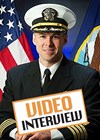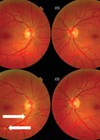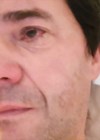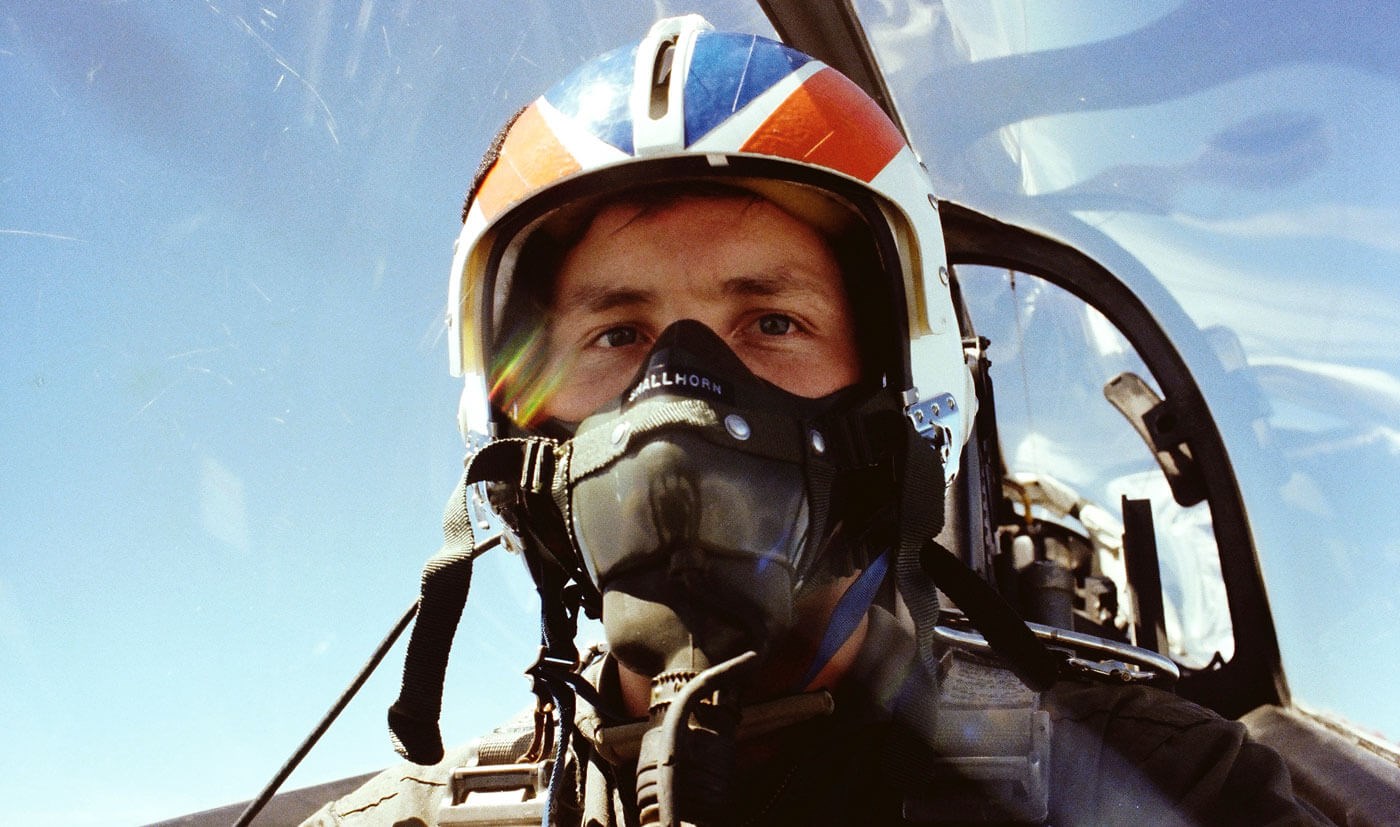
Steve Schallhorn: Fighter Pilot.
In the spring of 1987, I travelled to the cinema at Hendon Central in London with some school friends to watch the newly released movie The Witches of Eastwick starring Jack Nicholson and Michelle Pfeiffer. Unfortunately for me it was an 18 certificate, and because I looked underage the cinema attendant wouldn’t let me in. By default, I bought a ticket for the film showing in the adjacent screen, which was Top Gun, and ended up lucking out and seeing what has recently been voted the greatest film in the history of cinema. I was as high as a kite, or an F-14 fighter, as the final credits rolled.
Fast forward 35 years and at least a dozen viewings of Top Gun later I recently discovered that a US-based Ophthalmologist, Professor Steve Schallhorn, had been a fighter pilot in the US Navy in a former career. Not only that, but he had also been an instructor at the famous TOP GUN Fighter Weapons School at Miramar Naval Air Station, San Diego. And to top it all off, it was conversations about his experiences as a fighter pilot that he had with the Top Gun screenwriter Jack Epps, whilst he was an instructor at Miramar, that helped formulate the story for the movie.
Obviously, given my obsession with the film Top Gun, I was keen to try and interview Steve to find out more about life as a fighter pilot and the true life stories that made it into the movie. Through a good friend, I was connected with Steve. We meet virtually in late November.
My first questions to Steve are did he have any career aspirations growing up, and was he drawn to flying from an early age.
“I grew up in Denver during the Space Program in the 1960s. At grade school, a friend and I were way into aviation and rockets. We tracked the Mercury and Gemini rockets followed by the Apollo missions to the moon. At one stage I borrowed my parents’ car to drive from Denver to watch the Apollo 16 launch and I got 8mm footage of the Saturn 5 launch. We were so into the Space Program, that a friend and I built a scale model of the Apollo lunar module and command and service modules which ended up being displayed in various national aerospace museums.”
At that stage, however, Steve did not know what he wanted to do, but having a flair for physics he decided to study the subject at Colorado State University. Just before Steve graduated, he thought about going to medicine, but was still unsure. Then he describes a moment of inspiration where “a buddy and I decided to join the Navy and fly for them. It was on a whim, and I had no previous affiliation with the military.”
They visited the recruiter who flew them both down to Pensacola, Florida, which is the home of naval aviation. There he and his friend underwent a multi-day series of mostly medical examinations to make sure they were physically qualified for aviation. Steve explains: “The most intense of those were the tests to make sure you have really good vision.”
Unfortunately, his buddy had a minor amount of myopia in one eye and didn’t make the cut, and ultimately ended up flying commercial as a senior 747 pilot at Delta.
Steve passed the recruitment tests and entered flight training. Prior to that his experience had been limited. In fact, his first experience was in a Cessna 150 when he and a friend, who had just got his private pilot’s license, decided to go up and see the lights of Denver at night. They didn’t check the weather in advance, hit a storm front whilst airborne, and in poor visibility (IFR conditions) crashed into the side of a mountain. Fortunately, he and his friend walked away with minor injuries.
In training in Pensacola there are a series of milestones to pass until reaching service selection, where pilots are selected to fly helicopters, big transport airplanes or jets. “And of course, I wanted jets,” Steve says.
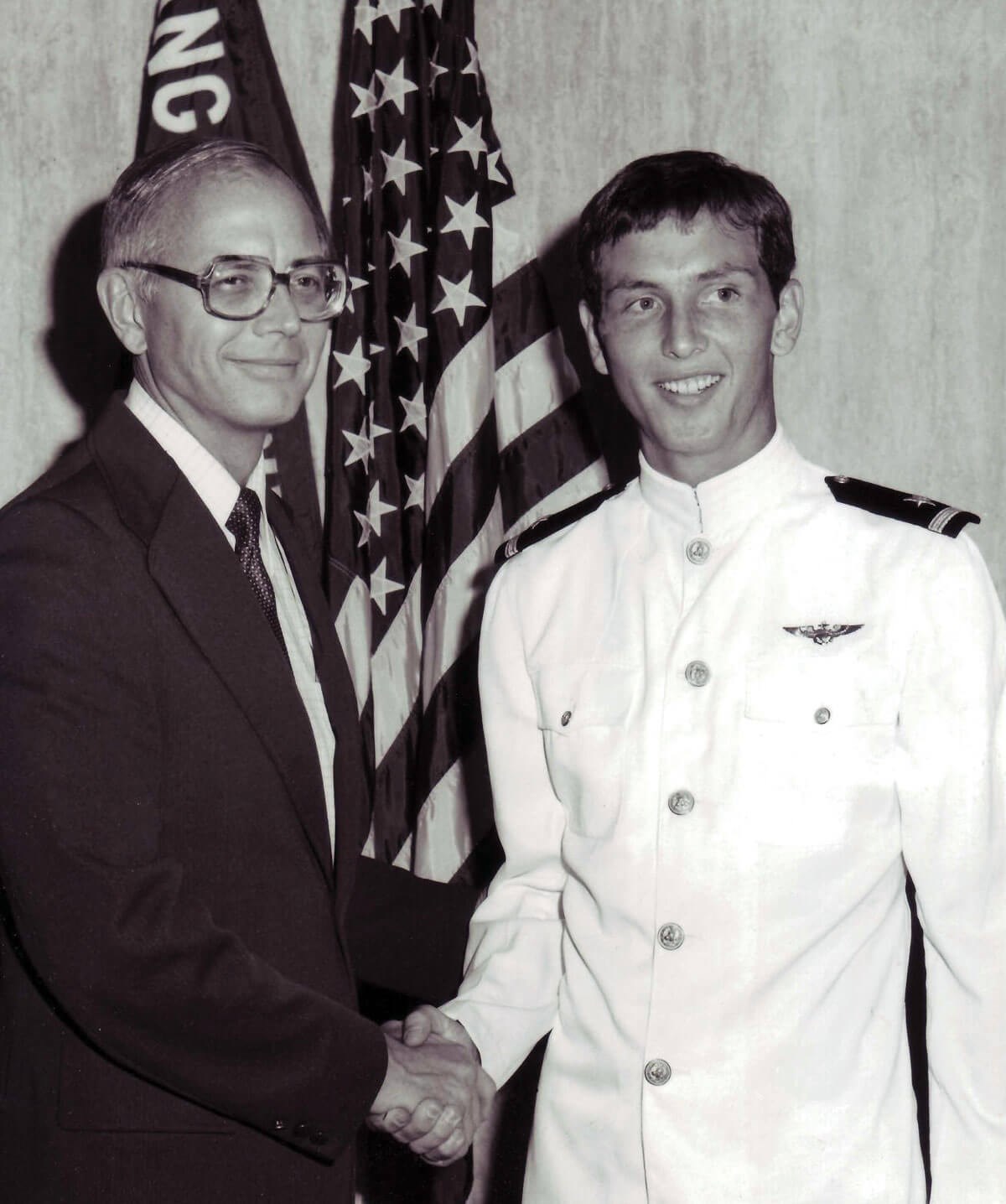
Steve winging ceremony with his father, 22 September 1978.
Steve was selected for jet training which was a very intense process taking several years. A major part of the training involved the difficult process of landing a jet on an aircraft carrier. “Some students couldn’t handle it,” Steve explains. “A lot of folks wash out in the process of landing on an aircraft carrier. It is both a technically and mentally demanding skill.”
“The biggest component is the mental challenge,” Steve continues. “You would train hundreds and hundreds of times in a simulator and field landings, but I’ll never forget the first time I landed on an aircraft carrier. I’m on the wing of an instructor, solo, nobody with me. Down relatively low, 600 feet above water and it’s turbulent. I came round to land and the feeling I had was as if you were to drive your car at 150 miles an hour towards a brick wall. At the instant before you hit this brick wall you have an overwhelming sense that this is it, I’m going to die.”
“And of course, the skills and training take over. The first time I trapped, you catch a wire and then right after you land you have to throttle back and raise the tail hook to free yourself from the wire. And my mind was working on a different level. So, I remember hearing through my headset radio ‘Buckeye 212 throttle back, godammit, Buckeye 212 throttle back’, and I thought, whoever that is, he really should do that. Then I thought, oh God that’s me.”
Steve was subsequently selected to fly F-14s as part of Fighter Squadron 2 on the USS Ranger aircraft carrier which was deployed to the Indian Ocean at the start of the Islamic Revolution in 1979. Tensions were especially high over this period when a group of US diplomats and citizens were taken hostage for over a year at the US embassy in Tehran. During Steve’s time on the USS Ranger, he was selected to go through the Top Gun course at Miramar. “That’s a huge, huge deal,” he explains. “There are 14 pilots in each squadron, and one crew get to go through the course maybe once every two to three years.”
“After the Top Gun course, which was several months long, I returned to my fleet squadron back in the Indian Ocean and was thinking about what I was going to do next. I was going to apply to medical school when I got the incredible message that I had been selected as a Top Gun instructor. That is something nobody in the world would ever turn down.”
Steve therefore returned to Miramar to take up his role as a Top Gun instructor, and it was during this tour that he became involved in the story for the movie Top Gun. In this article there now follows a discussion of this episode and spoilers for the film, but it is 35 years since it was released so if you haven’t seen it by now, you really should.
Once a month a dignitary would typically visit the Top Gun school, such as a senator or someone big in media, and one of the 12 instructors would be assigned to them to chaperone them and talk to them. “So, it was my turn,” Steve explains, “and it just so happened that this guy was someone writing a script for a movie. And that was Jack Epps, the scriptwriter for Top Gun. So, I spent some time talking to him about Top Gun school and naval aviation.”
I then proceed to ask Steve about some of the plot lines in the movie, to try and distinguish fact from fiction. The opening scene of the film sees the F-14 pilot Maverick (Tom Cruise) stationed in the Indian Ocean aboard the USS Enterprise. Both he and another F-14 pilot, Cougar, are sent to intercept two hostile MiG-28s. Cougar loses his nerve during the resulting interaction and requires the help of Maverick to shepherd him in to land back on the aircraft carrier at night. As a result, Cougar hands in his wings. He had been about to be sent for Top Gun school training, and by default Maverick, the second choice, takes his place. This actually happened in real life, when a pilot in Steve’s squadron on the USS Ranger in the Indian Ocean had a difficult time landing on the aircraft carrier at night and handed in his wings, with Steve subsequently getting the call-up for Top Gun school.
Also, in the opening scene we see Maverick flying his F-14, canopy to canopy, with an MiG-28 and his radio intercept officer (RIO) Goose photographing the episode. On his first day at Top Gun school, Maverick then proceeds to tell the astrophysicist and civilian instructor Charlotte “Charlie” Blackwood that her information is incorrect, and he had witnessed an MiG-28 doing a 4G negative dive. I ask Steve about the accuracy of this scene to which he replies: “That was all Hollywood. You would never pull minus 4G. You would simply roll the plane and pull positive G. So that whole scene, you know canopy to canopy, was completely fictional, completely Hollywood.”
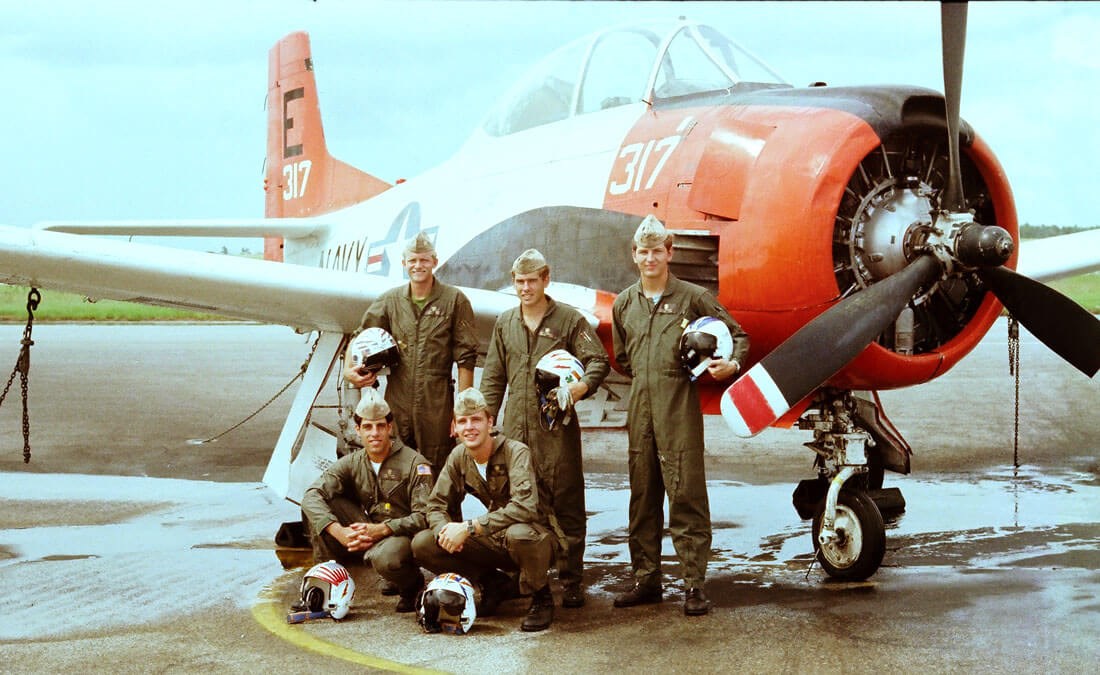
Steve undergoing training in T-28 Trojan.
On a couple of occasions in the film, Maverick “buzzes” the control tower in his F-14, causing an officer to spill his tea. I ask Steve if he ever did this to which he explains: “There’s an enormous amount of professionalism in military aviation and certainly in Navy pilots. If you did something so egregious as buzzing the Miramar tower supersonic, you would probably never fly again.” So, there you have it, Maverick would have been fired.
I then enquire about the scene later in the movie where Goose dies. During a training exercise, Maverick and Iceman are fighting an A-4 aircraft. Maverick can’t get a shot and rolls off so that Iceman can get into a firing position. In doing so, Maverick flies through the A-4 jet wash and suffers a flameout in one engine, with his F-14 going into a flat spin. During ejection from the aircraft, Goose hits the canopy and dies.
I ask if this scene has any bearing in reality, to which Steve replies: “This scene very accurately represents what happened in my F-14 squadron. This was a graded exercise where one of the F-14s was chasing an A-4 in a hard turn under high G and couldn’t get a shot off. His F-14 wingman was overhead and was going to roll in to shoot down the A-4. Aircraft leave a jet wake of air disturbance thousands of feet behind it and the first F-14 hit the jet wash of the A-4 resulting in one of his engines blanking out. When one of the F-14 motors blows out in a high G turn you can get into a flat spin, and that’s what happened. When an F-14 is in a flat spin it’s falling like a rock but spinning very fast. Recovery is not possible, and you need to eject. There are two crew, the pilot and the RIO. Because of the extreme forces involved, the RIO, who is closer to the centre of rotation, needs to initiate the ejection. In addition, because of the unusual aerodynamics of a falling, spinning F-14, the canopy bobbles for an extra millisecond so that the RIO could hit it. That’s what happened in my F-14 squadron.”
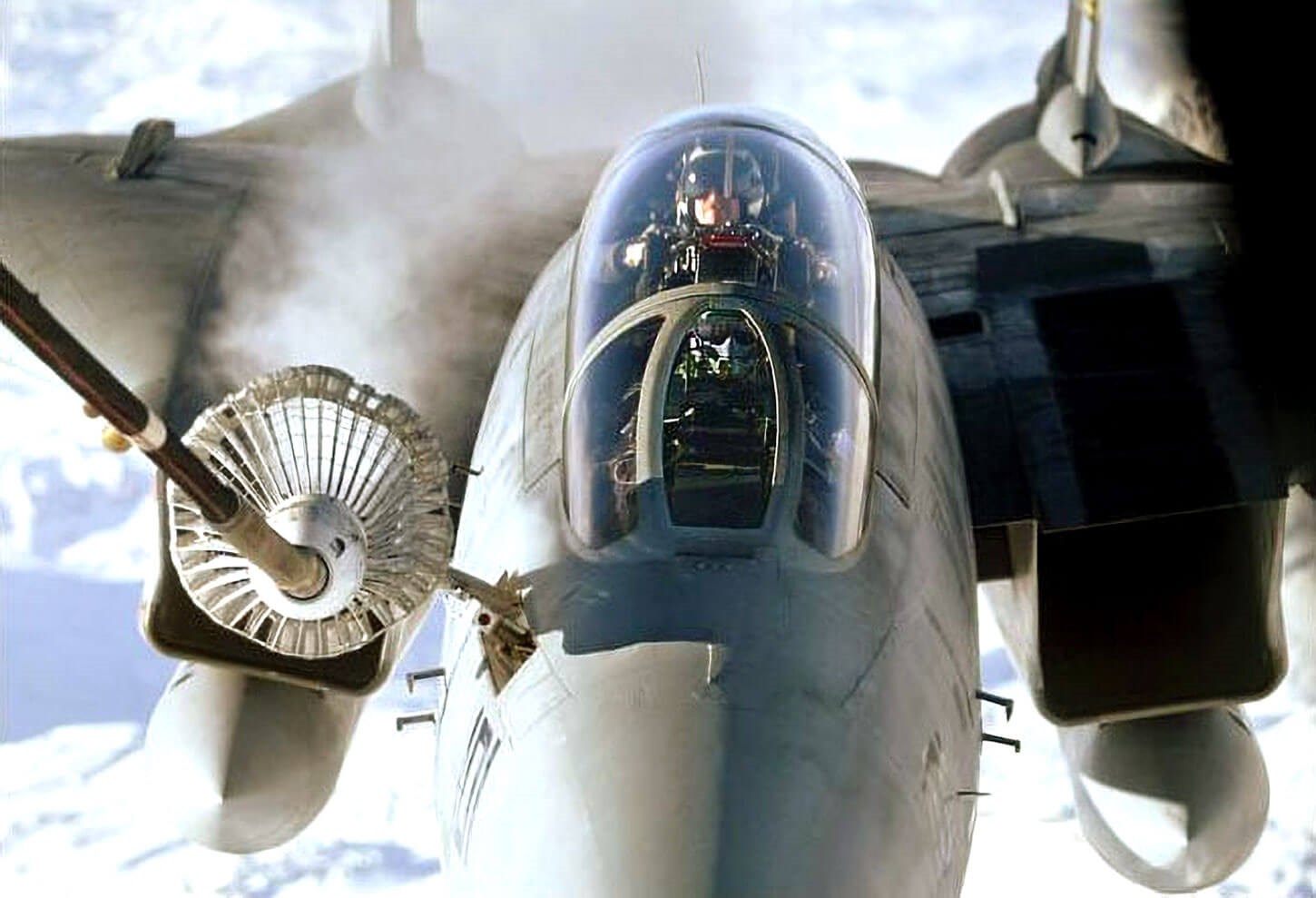
F-14 tanking.
In this incident in real life both men fortunately survived. However, the RIO dislocated both shoulders and Steve explains that it was lucky that the incident happened over land as the RIO may not have been able to pull the inflating vest if he had landed at sea and could have drowned.
Steve tells me that Top Gun ended up being an enormous recruiting tool for the Navy, with the Navy getting out of it probably as much as the movie producers from being able to film on an aircraft carrier. He also goes on to say that in both movies, Top Gun and the recently released sequel Maverick, the flying scenes are pretty accurate, but the second movie really does portray the physically demanding nature of dogfighting. “One of the most significant aspects of a dogfight are the physical demands that are placed on you, you’re generally under very high G, which is like somebody standing on your head while you’re turning your head continually. Another important aspect is vision.”
We then discuss the visual requirements for being a fighter pilot. Steve explains that it costs millions of dollars to train a fighter pilot, so a study was done in the 1980s to find out how the military could select better pilots to train and reduce the washout rate. They looked at F-14 pilots and a whole host of different things: personality traits, physical characteristics, a lot of vision tests, including dynamic visual acuity, contrast sensitivity, down to what kind of car they drove.
“They came up with only one thing in the end that mattered and that was uncorrected visual acuity. This was the strongest correlator to being a better fighter pilot. So, a F-14 pilot who is just 20/20 uncorrected is not nearly as good as a pilot who is 20/16, 20/12 or 20/10.”
Returning to dogfighting, Steve describes the importance of good visual acuity. “The aircraft are generally far apart in a dogfight. You have an airplane that’s maybe two miles away and you’re turning very hard under high G. If you can see the control surfaces of the other aircraft, you get an indication of what that pilot is planning and how hard they’re turning. That requires excellent visual acuity under the duress of high G. If you lose sight in a dogfight, you will be shot at within a few seconds.”
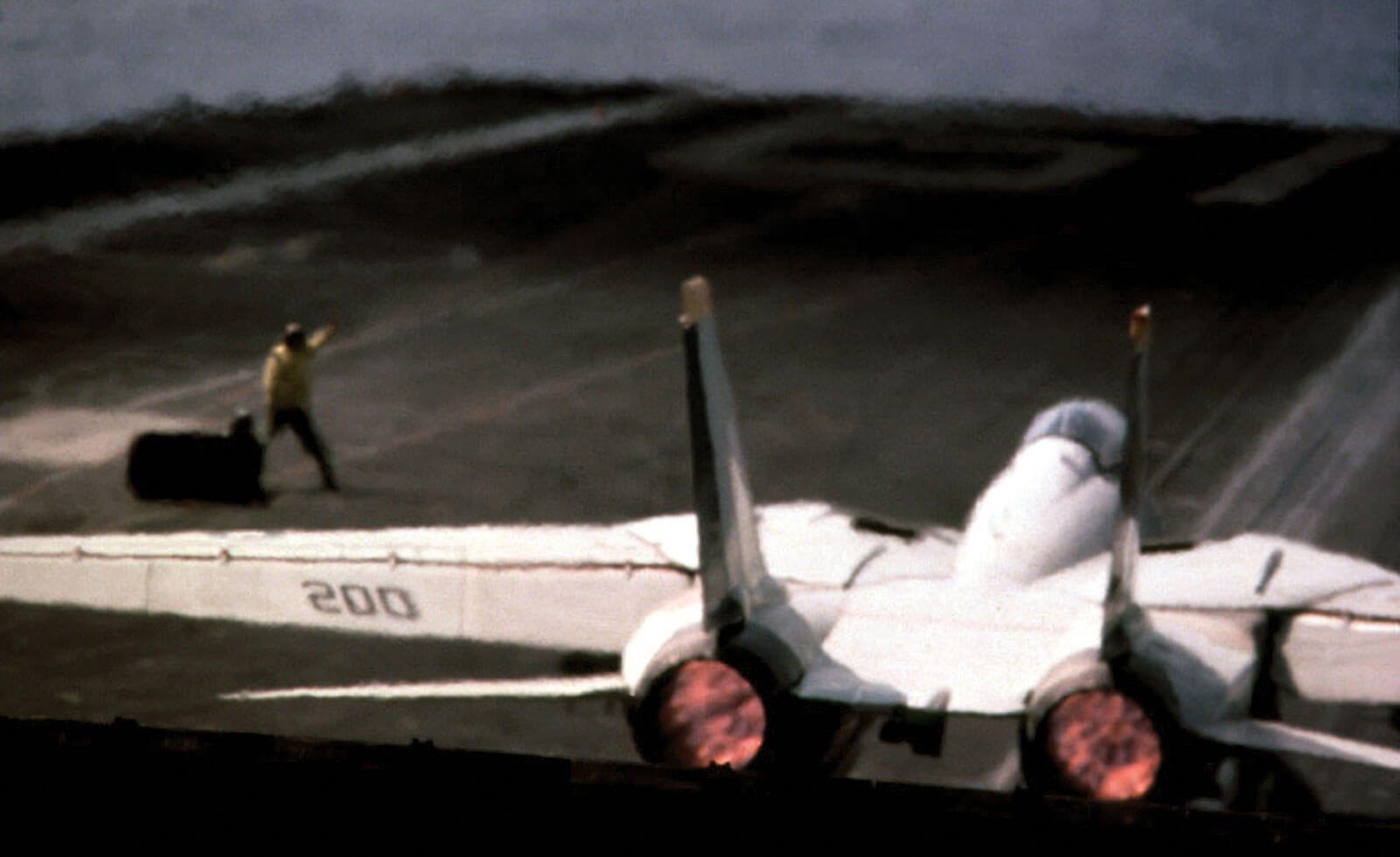
F-14 catapult.
The speed at which dogfights take place now is 400 to 600mph, compared to about 100 to 200mph in the Second World War, and such high speeds also makes it hard to keep situational awareness in an air battle. “In reality, a dogfight can involve multiple bad guys and it’s really difficult keeping track of everybody. Your wingman can help keep track of the other bogeys and your RIO certainly helps out also. Recognising friend versus foe in a dogfight is a critical component and that goes back to visual acuity. Is that aircraft three or four miles away my wingman, or a bogey?”
Then I ask Steve about the sensation of flying a fighter aircraft which I had previously heard, anecdotally, is the best feeling imaginable. He replies: “Everyone asks me what it’s like to go Mach 2 or Mach 2.5. The answer is that at Mach 2 there is almost no sensation of speed at altitude. It’s the same sensation as flying in an airliner on British Airways, where you’re doing 550 miles an hour at 30,000 feet. The real sensation of going fast is when you’re low and fast.”
He continues: “Speed is one thing, but another is air combat, there’s nothing like the thrill of being in a dogfight. Another incredible experience is aircraft carrier aviation. Flying on and off carriers is nothing short of unbelievable. You have 5000 people on an aircraft carrier and the whole carrier battle group, all supporting what you’re doing, your mission.”
During Steve’s time stationed in the Indian Ocean, at the height of tensions with Iran, Steve would regularly intercept the Iranian fighter aircraft and escort them, but there was no aerial combat at the time. Interestingly, prior to the Iranian Revolution, Iran had been an ally of the US and therefore the Iranians were flying the same aircraft, including F-14s. The Iranians would fly out to the aircraft carriers hundreds of miles off the coat to harass them and he would escort them away. “Some of the pilots in the Iranian aircraft were quite hostile, but it never got to shooting.”
I was interested to find out the pilots’ recreation after the working day. Returning to the movie Top Gun again, towards the start of the movie, Maverick unsuccessfully approaches Charlie Blackwood at the Miramar officers’ social club. I ask if this bar and the party atmosphere existed in reality. He replies: “On a Wednesday night the ‘WOXOF’ Room at the officers’ club was the place to be. WOXOF is the flying initialism for zero-visibility, pea soup conditions, you can’t fly.” Steve then describes a story about the club.
“My next-door neighbour in the Navy was an arrogant cardiothoracic surgeon at the time I was a Top Gun instructor. He dated extensively and he had a really nice, red hot new Corvette. He and I talked, and he knew about Wednesday night at the Miramar officers’ club and said well, we’ve got to go. So, one day we went there, and he parked in the admiral’s space right in front. We go inside, it’s a very lively place. Later we walk outside for a moment and there are two beautiful women that are draped over his Corvette. He says, “Hello ladies,” and they respond, “Well, what do you fly?” He says “Here’s what I do. I operate on hearts, hold them in my hand and save lives.” They go, “So does that mean you don’t fly? What are we doing here?” He was instantly deflated, and I felt good about being a pilot.”
After Steve’s tour as a Top Gun instructor, he returned to the USS Ranger to train the other pilots on the aircraft carrier. However, he felt that he had reached the top in Naval aviation and that it was time to move on and do something different, so he finally applied for medical school which he had thought of doing years earlier. He subsequently went to medical school in Bethesda, Maryland at the Uniformed Services University. After qualifying as a doctor, he completed an ophthalmology residency at the Balboa Navy Medical Center, San Diego. I ask Steve what attracted him to ophthalmology, and he replies: “Knowing how important vision was in aviation, there was a natural attraction to it. You know as well, ophthalmology is the best specialty, it has great surgery, utilises the latest technology, routinely improves patient’s lives, and you can maintain a high quality of life.”
Following this he did a corneal, external eye disease and refractive surgery fellowship at the Doheny Eye Institute, USC. I am interested to know why Steve chose cornea as his subspecialty. He tells me: “It seemed like a natural fit; I was intrigued by refractive surgery. In the early 90s radial keratotomy was being performed and excimer lasers were undergoing clinical investigation. I took part in one of the first Food & Drug Administration (FDA) clinical trials of the excimer lasers, which was offering something completely unique. Through these trials we realised these procedures and could offer the military something very, very meaningful.”
He continues: “I spearheaded the Department of Defence refractive surgery program. There are now more than 20 centres in the program that have performed close to a million refractive surgery procedures.” I enquire why refractive surgery was so important to the military to pursue. He explains: “There are several different aspects to it. One is to enhance their performance, to help them do their jobs better. There is a well-earned expression that better vision equals better war fighters. Many folks in the military are near-sighted, and this could result in a form of disability. Here’s one example. Gas masks are an integral part of military preparedness and contact lenses cannot be worn with the masks for a variety of safety reasons. So, you clip vision correcting inserts into your gas mask. Those inserts can be dislodged or displaced, or you could accidentally put on somebody else’s mask; all of these have happened with some frequency, resulting in a disability. Reducing dependence on vision correction through refractive surgery can improve performance. This also highlights the significant safety aspect of vision-correcting surgery. Then there’s the improvement in quality of life, very common after surgery, which is just as important for military folks as it is for the general public.”
Refractive surgery has also opened the doors for more people to become military pilots, as people who have undergone laser vision correction can now be accepted. This had led to higher quality recruits as there is now a larger pool of individuals to select from. Furthermore, if a pilot has a small treatable refractive error at 20/20 which can be improved to 20/16 or 20/12 then this could improve their performance.
Steve informs me that the Department of Defence refractive surgery program is widely acclaimed as being enormously beneficial.
“Military medicine throughout history has taken war fighters that are injured or disabled and returning them to duty. Now there’s a procedure that takes a healthy war fighter and improves their performance.”
NASA also became very interested in refractive surgery, as many astronauts wore contact lenses and there’s significant issues wearing contact lenses and glasses in space. Steve goes on to explain that glasses in zero gravity, unless they are tight fitting, can float on the bridge of the nose, resulting in a disturbing and sometimes nauseating prismatic effect. Therefore, almost all astronauts wear contact lenses, but there are issues with them. Prolonged contact lens use has a well-known set of problems, handling lenses is more difficult and even putting eye drops into the eye is challenging in zero gravity. “So, NASA said, if refractive surgery is good enough for a Navy pilot, maybe it’s good enough for an astronaut. So, after years of careful consideration and studies, NASA ultimately accepted laser vision correction. There are now astronauts that have had refractive surgery.”
Steve continues to work occasionally with NASA and is in close communication with the military to help steer, guide and advise them, but the refractive surgery program is fully running on its own.
I then ask Steve about his life and career pathway and if he has any advice for others. He counts himself as being very fortunate and blessed, making good choices that ended up being favourable and being in the right place at the right time. He also describes having good mentors along the way. “My advice is that where you get to in life is, as I told my kids, 10% what you’re born with and 90% what you do with it.”
He also describes a piece of advice from his first commanding officer, “Burner” Bob Hickey, when he was a junior F-14 pilot in his squadron, which was:
“If you’re not having fun, you’re not doing it right.”
Steve continues: “This stuck with me, and I think about it continually. You have to like what you’re doing, and if not, do something about it.”
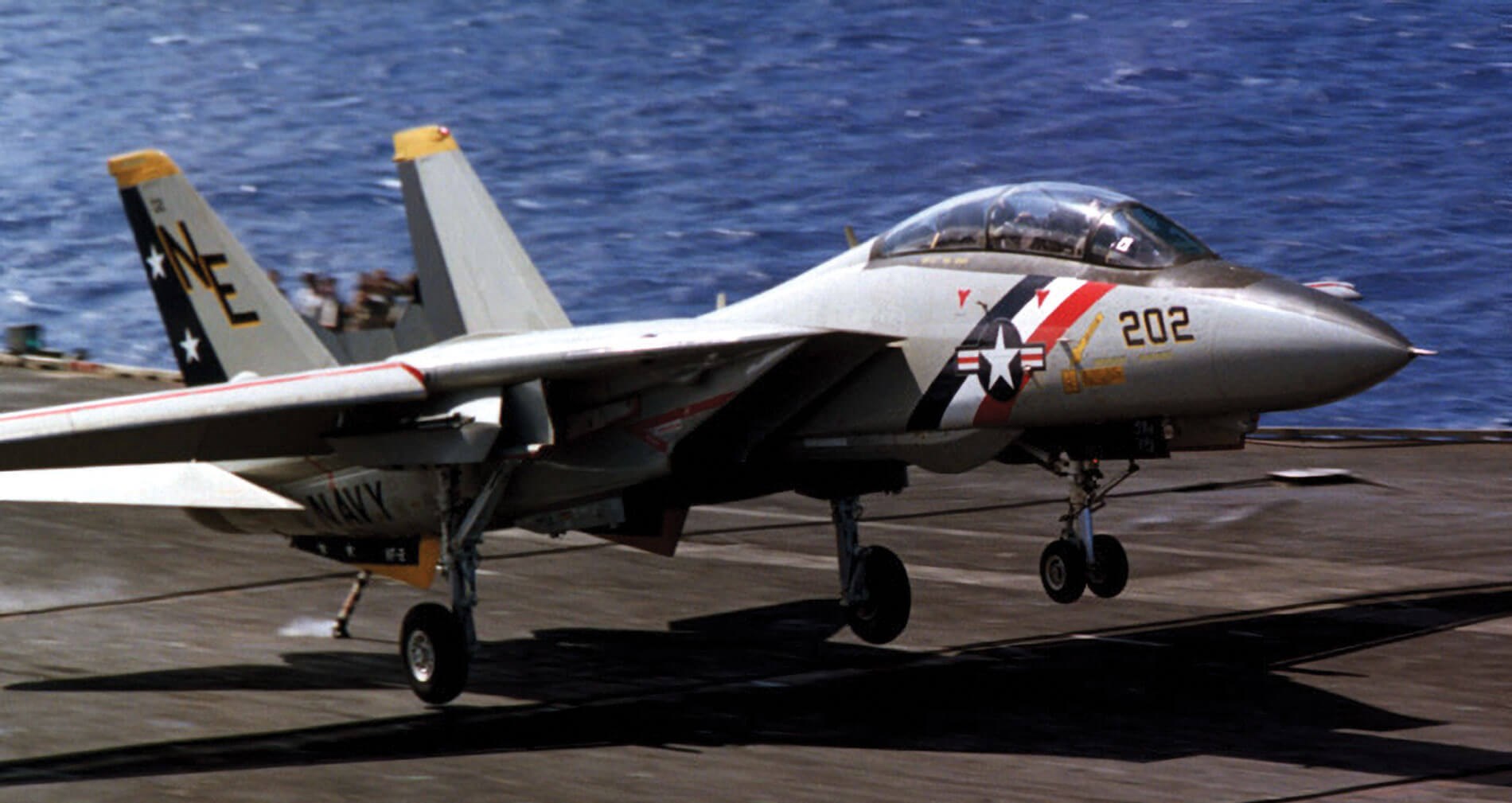
F-14 carrier landing.
Moving back to aviation again, I ask Steve which aircraft was the most fun to fly. For him it was the F-14, which was the most thrilling as it was the latest generation aircraft at the time with the best technology, and it also had afterburners. He explains that the afterburners provide thrust augmentation. The jet engine has a compressor section, a burner section, and a turbine section, and during engagement of afterburners the engine turns into a rocket and produces an enormous amount of thrust. “It turns the F-14 basically into a rocket.” The downside is that fuel consumption is astronomically high. “The F-14 can carry 20,000 pounds of gas and can stay airborne for four plus hours and fly 2000 miles. In full afterburner it burns all that fuel in less than four minutes.” Essentially, afterburners are only used during take-off and air combat where the most thrust is needed. “You’re almost always in full afterburner during an engagement, but because of the speed, turn capability and advanced weapons, the engagements are very short, a minute or two at most. That short time may encompass many manoeuvres under high G and the afterburner is essential.”
“There’s nothing like the thrill and power of engaging the afterburners. Here’s an example. My first flight in an F-14 consisted of flying at 500mph alongside the cliffs of San Clemente Island, which is about 50 miles off the coast of San Diego. I then engaged full afterburner and pulled the nose straight up. In less than a minute I topped out at 45,000 feet while breaking the sound barrier going up. The sky gradually turned a darker blue and I could appreciate the curvature of the earth. It’s an experience I will never forget.”
I then ask Steve if he has any advice for medical students embarking on their career in medicine. He replies: “Work hard, initially it’s not going to be a lot of fun. The fun / reward will come later. Seek and cherish good mentors, evaluate different fields, and choose the best fit for you.”
On the meaning of life, Steve has this to say:
“Don’t think just of yourself but how your actions can improve the lives of others. Think of how you can help mankind.”
To sign off, I have a final aviation question for Steve. In the movie Top Gun, all the pilots have call signs such as Merlin, Jester, Hollywood, and Viper. I ask Steve if he had a call sign and if so, what it was. “My call sign was ‘Legs’. Everyone in aviation knew me as ‘Legs’. They may not have known my real name but that’s how we called each other, by your call sign.” He explains that each aviator’s call sign was usually assigned during flight training by their peers in their squadron. There was always a unique angle or story to the call sign, usually funny. I enquire about the story behind Steve’s call sign ‘Legs’. He replies:
“There is a bit of a story and I hesitate to talk about it in polite company. If anybody wants to know more, it would have to be at an officers’ club with a beer.”
COMMENTS ARE WELCOME





